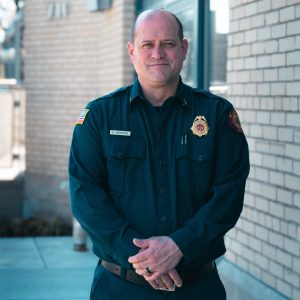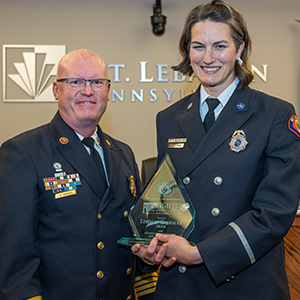Planting street trees
The Mt. Lebanon Nature Conservancy is working with the public works department to find ways of diversifying trees planted along streets and in parks, thus strengthening the “urban forest.”
Ten percent of Mt. Lebanon’s 10,000 street trees are mature ash trees, once considered the “perfect” street tree. Sadly, over the next decade we can expect to lose most of these trees to the deadly emerald ash borer, which has already begun to decimate trees in this area.
Ash trees can be treated for the disease, says Public Works Director Tom Kelley. In fact, trees that have lost up to 60 percent of their canopy can be brought back if treated with a product called Tree-age (pronounced “triage”). But that treatment is labor intensive and expensive, so it is unlikely public works will be able to save the bulk of the ash trees.
Keeping up with trees’ needs is a daunting challenge for public works, particularly now, when crews have spent long months cleaning up from last summer’s microburst. Currently they are pruning to prevent oak blight, another impending threat.
“Our three-man crew using ropes and saddles can trim about three trees per day,” says Public Works Superintendent Rudy Sukal. “We get 10 calls for service per day.”
This fall Mt. Lebanon planted $19,000 worth of trees—about 260 trees—on local streets, in some cases replacing large trees that were lost during the microburst or weakened by the electric company’s three-year pruning cycle, in an effort to prevent extended power outages. In recent years, the majority of the street trees planted have been sturdy varieties of maples such as red maple and hedge maple, which are also heavily represented in forests in this zone.
But the crises facing ash and oak trees raises the question, “What if some sort of disease should wipe out all the maples?”
With that in mind, the parks advisory board and the Mt. Lebanon Nature Conservancy are working with public works to explore diversifying the sort of trees that are planted on Mt. Lebanon’s streets, as well as in parks and other public areas.
The goal is to promote “a healthy urban forest,” says Susana Montoya of the parks advisory board.
Conservancy President Ron Block, a former member of the historic preservation board, sees trees as a prominent and significant feature of Mt. Lebanon’s built environment.
“We need to think not just about how Mt. Lebanon looks now,” he says, “but how it will look in 20 years.”
Diversifying the sorts of trees planted on the streets is not an easy task. Both their suitability to the environment and their growth habits need careful consideration, Sukal says. A tree cannot soar so high that it will interfere with power lines, requiring the grotesque pruning our surviving sycamores and other large trees have undergone. Its canopy cannot grow so wide that it endangers pedestrians or drivers. How it grows underground also is a concern, because roots entwined in sewers spell trouble. Finally, a tree needs to be able to survive in this zone’s soil and weather conditions and be resistant to road salt.
Some beautiful trees such as hawthorne and crab apple that once seemed like good choices have been eliminated, Sukal says, because they bear fruit or berries that yield complaints from homeowners who step on them or have to do cleanup duty. And the popular pears are being planted less frequently because they too often succumb to blight. Ginkgos, which otherwise might seem perfect, are problematic because you can’t tell the difference between a male and female tree—until the female matures and, well, stinks.
In addition to the maples, this fall public works planted linden trees and, for the first time, ivory silk lilacs, a fast-growing tree that grows to 20 feet and bears snow white blossoms in the spring.
Sukal and Kelley share Montoya and Block’s goal of diversifying the stock, provided he can find appropriate trees that a single nursery can supply (the most cost-efficient way of purchasing trees in bulk).
Once in a blue moon, Mt. Lebanon gets a new street with underground utilities, and Sukal gets to plan and plant from scratch—a forestry dream. In those cases, he chooses at least four varieties of trees. He still needs to consider what will happen underground, but he can select trees that grow a little taller, like the sycamores and oaks that we’ve lost, a reminder that everything old is new again!
JOIN THE PARADE

Mt. Lebanon officially begins celebrating its centennial year on February 6, 2012, but it’s pretty likely that nobody wants to stand on a street corner in sub-zero weather to watch a parade (unless the Steelers win the Super Bowl). So we have chosen a much balmier Saturday, September 8, for the celebration.
The fire department is heading up a committee that will organize a grand parade. The parade will start near the high school, progress along Washington Road and end at Mt. Lebanon Cemetery. Start time will be at 3 or 4 p.m., depending on how many groups participate. Local organizations are encouraged to enter floats.
Bands, performers, ethnic clubs, re-enactors and other entertaining groups are invited to march. Convertibles are needed to drive dignitaries and local heroes. The parade will end by 6 p.m. Uptown followed by a street party with food, music and entertainment. For information, contact Fire Chief Nick Sohyda, 412-343-3402, nsohyda@mtlebanon.org





